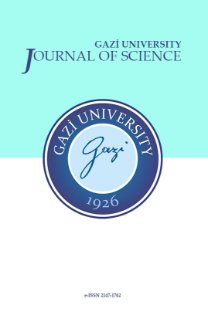The Current-Voltage Characteristics for Electrode Geometry Model of Positive DC Corona Discharge in Air
Corona discharge, (I-V) characteristics curve, PSC-P, Python GUI Programming, k-shape sharpness factor,
___
- [1] Allen, J., “The plasma-sheath boundary: Its history and Langmuir's definition of the sheath edge”, Plasma Sources Science and Technology, 18(1): 014004, (2008).
- [2] Stambouli, A. B., Benallal, R., Oudini, N., Mesli, S. M., Tadjine, R., “Control of Dual Frequency Capacitively Coupled Plasma via blocking capacitor and phase angle”, The European Physical Journal Applied Physics, 80 (1): 10802 (2017).
- [3] Saikia, P., Bhuyan, H., Escalona, M., Favre, M., Wyndham, E., Maze, J., Schulze, J., “Study of dual radio frequency capacitively coupled plasma: an analytical treatment matched to an experiment”, Plasma Sources Science and Technology, 27(1): 015014, (2018).
- [4] van Veldhuizen, E. M., Rutgers, W. R., “Corona Discharges: Fundamental and Diagnostics”, Frontiers in low temperature plasma diagnostics IV: papers, Rolduc Conference Centre, The Netherlands, 40-49, (2001).
- [5] Dau, V. T., Dinh, T. X., Terebessy, T., Bui, T. T., “Bipolar corona discharge based air flow generation with low net charge”, Journal of Electrostatics, A, 244: 146 – 155, (2016).
- [6] Guan, Y., Vaddi, R. S., Aliseda, A., Novosselov, I., “Analytical model of electro-hydrodynamic flow in corona discharge”, Physics of Plasmas, 25(8): 083507, (2018).
- [7] Robinson, M., “Convective Heat Transfer at The Surface of A Corona Electrode”, International Journal of Heat and Mass Transfer, 13: 263-274, (1970).
- [8] Robinson, M., “Movement of air in the electric wind of the corona discharge”, Transactions of the American Institute of Electrical Engineers, Part I: Communication and Electronics, 80: 143–150, (1961).
- [9] Robinson, M., “A History of the Electric Wind”, American Journal of Physics, 30: 366-372, (1962).
- [10] Robinson, M., “Turbulent Gas Flow and Electrostatic Precipitation”, Journal of the Air Pollution Control Association, 18(4): 235-239, (1968).
- [11] Bush, J.R., Feldman, P.L., Robinson, M., “High Temperature, High Pressure Electrostatic Precipitation”, Journal of the Air Pollution Control Association, 29(4): 365-371, (1979).
- [12] Townsend, J. S., "The potentials requires to maintain currents between coaxial cylinders", Philosophical Magazine (London), 28: 83-90, (1914).
- [13] Dobranszky, J., Bernath, A., Marton, H., “Characterisation of the plasma shape of the TIG welding arc”, International Journal of Microstructure and Materials Properties, 3(1): 126-140, (2008).
- [14] Ferreira, G. F. L., Oliveira Jr., O. N., Giacometti, J. A., “Point‐to‐plane corona: Current‐voltage characteristics for positive and negative polarity with evidence of an electronic component”, Journal of Applied Physics, 59: 3045, (1986).
- [15] Zheng, Y., Zhang, B., He, J., “Current-voltage characteristics of dc corona discharges in air between coaxial cylinders”, Physics of Plasmas, 22: 023501, (2015).
- [16] Robinson, M., “The Corona Threshold for Coaxial Cylinders in Air at High Pressures”, IEEE Transactions on Power Apparatus and Systems, Pas-86: 2, (1967).
- [17] Goulden, C. H. “Methods of statistical analysis”, USA: John Wiley & Sons, (1949).
- [18] Taylor, J. “Introduction to error analysis, the study of uncertainties in physical measurements”, second edition, California: University Science Books, (1997).
- Yayın Aralığı: 4
- Başlangıç: 1988
- Yayıncı: Gazi Üniversitesi, Fen Bilimleri Enstitüsü
Mohamed BENZAGHTA, Burak ER, Gulsima BİLGİN, Elif AYDIN, Ali KARA
Anılcan ÖZKAN, Hikmet ARSLAN, Osman Taha ŞEN
Mehmet YILDIRIM, Mustafa ÖZCAN
Ayebatonye EPEMU, Donatus ONYİSHİ, Simon OBE
Ibrahim ELBATAL, Selen ÇAKMAKYAPAN, Gamze ÖZEL
Safar MOHAMMED, Fethi DAĞDELEN, Ibrahim Nazem QADER
Hadi ZAVİEH, Hadi NASSERI, Chefi TRIKI
Süleyman Hilmi YILMAZ, Edip TAŞKESEN, Khandan ROSHANAEI, Mehmet ÖZKAYMAK
Asep Yoyo WARDAYA, Zaenul MUHLİSİN, Jatmiko Endro SUSENO, Muhammad NUR, Pandji TRİADYAKSA, Ali KHUMAENİ, Eko SARWOKO, Jaka WİNDARTA, Susilo HADİ
